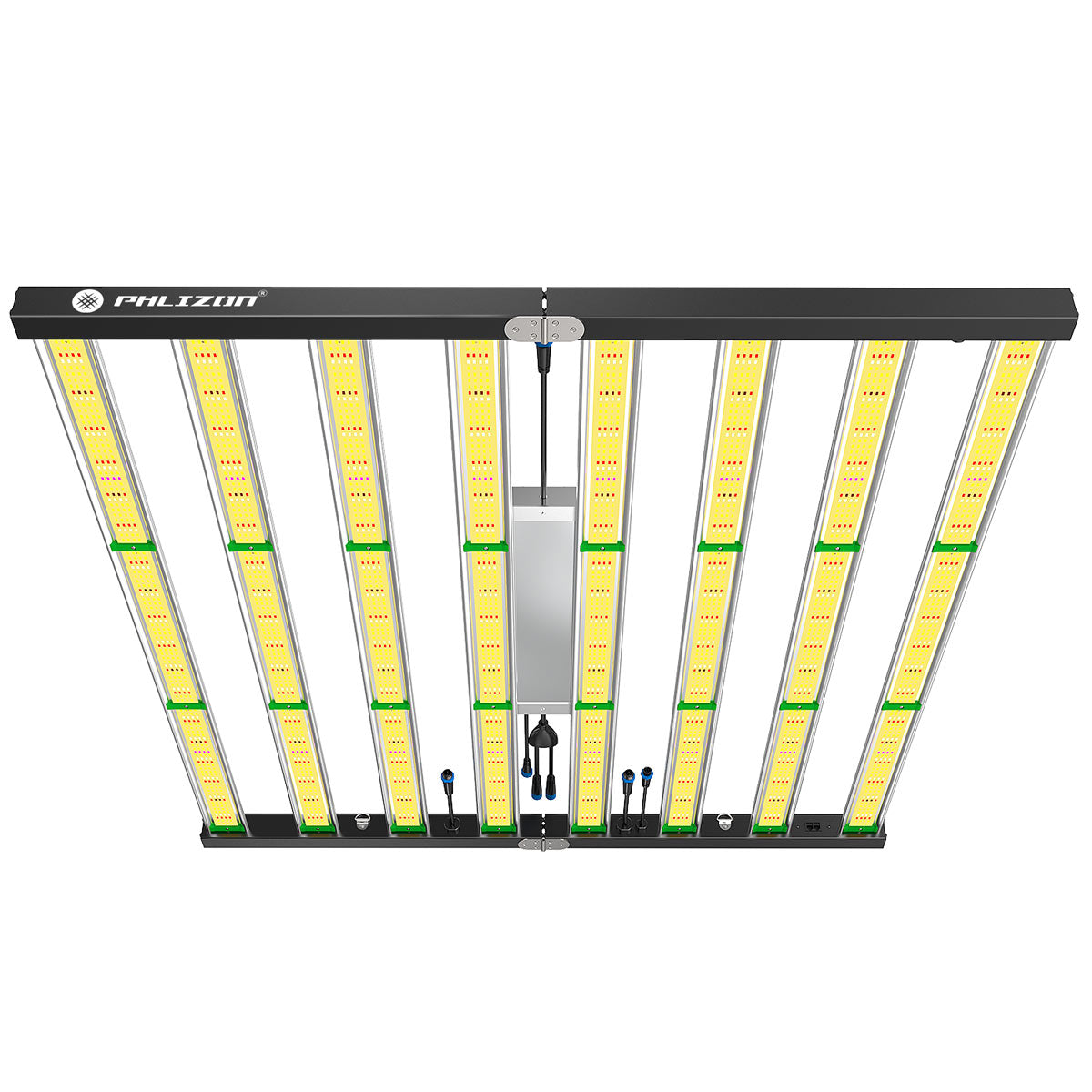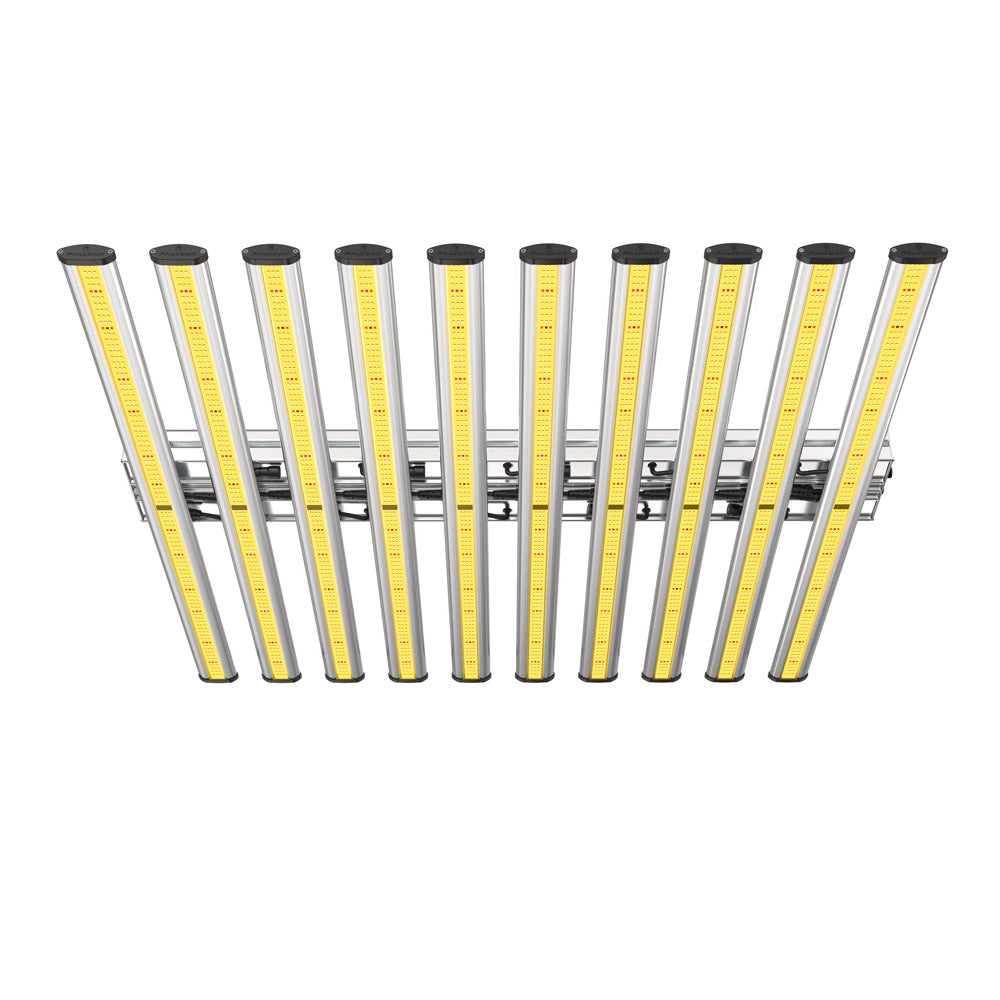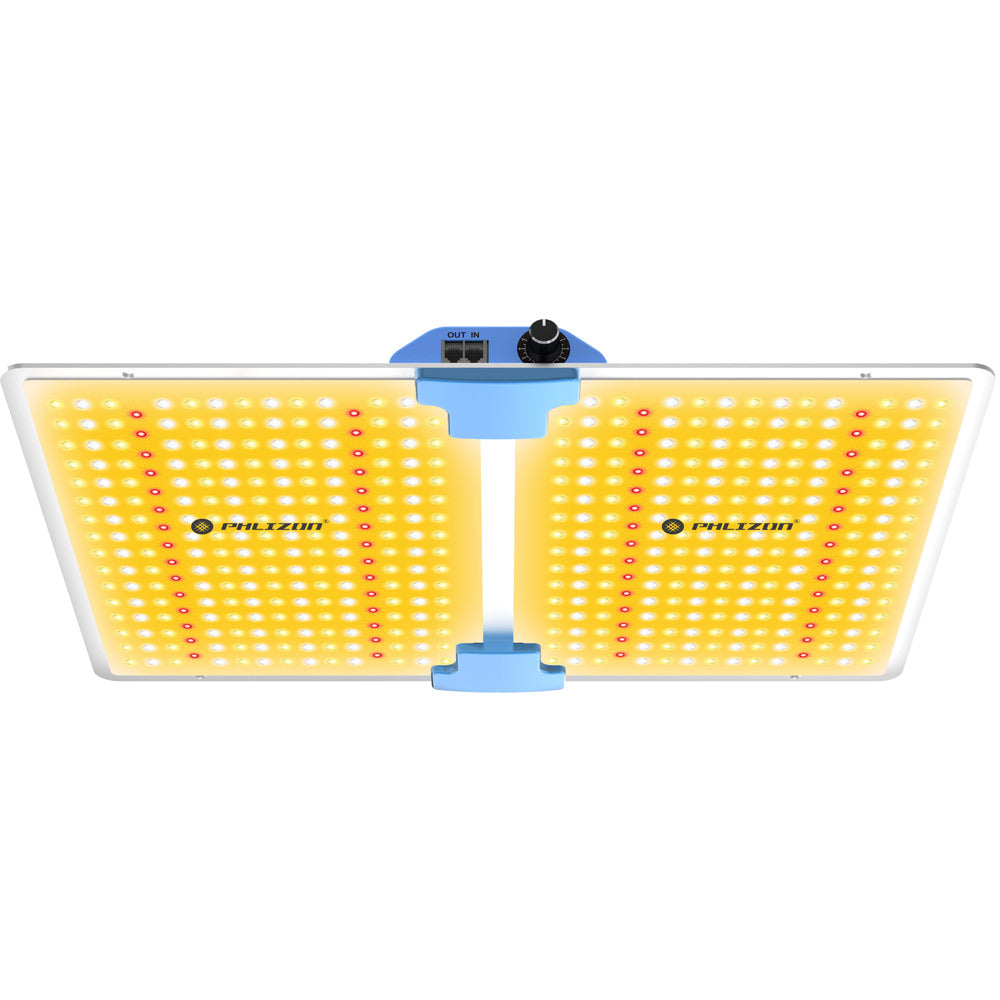Menu
Can I Use Regular LED Strip Lights to Grow Plants?
The sunlight-abundant exposure to outdoor plants would understandably mean an optimal growing environment for plants to flourish and develop outstanding anatomy. But when you bring these plants indoors or establish greenhouses, the struggle to recreate the sunlight inside is really a perennial challenge!
In the ever-expanding realm of indoor gardening, LED grow lights are an optimal and sustainable solution to nurture these leafy companions. But among the various varieties of LED options we’ve, can the ever-present LED strips adorning our homes and workspaces contribute to horticulture progress or fuel the plant's growth?
Well, It's a captivating inquiry that made us dig into the intricacies of light science and plant biology. In this blog, we embark on the journey of knowing whether or not Regular LED grow light strips can be a nurturing agent for thriving plant life. So, Stay tuned!
I. Do LED Strip Light Emit Light For Photosynthesis: Solving the Mystery
Understanding sunlight chemistry with plants is the best guide to knowing whether an alternative, like LED strips, can be used as a substitute. Studies reveal that light initiates the chemical reaction of carbon dioxide to sugar, known as photosynthesis.
Theoretically, plants trap light energy in the form of photons–the unit of light. So, ideally, any object that emits photons can process this mechanism.
Now, because Full spectrum LED grow light strips can emit the entire color of the spectrum with less electricity consumption and lower heat discharge, this appears to be a favorable fixture to put over plants.
However, digging deeper, we get to know that not all LED grow light strips emit sufficient intensity to let photosynthesis work. By this, we mean you require a brightness of around 2000 lumens per square foot for plants to synthesize. If your LED strip has 5050 chips (50 widths, 50 height), it can reach the 2000 lumen level needed for plants.
If this lumen score is low, as with many regular LED strips having around 450 lumens, unfortunately, it won’t be contributing enough for the chemical reaction to occur.
So, what we summarize here is that to see a plant through the whole of its growing cycle, it’s a good idea to have lighting at a level of around 2,000 lumens per square foot at least, or you might use it to supplement other lighting forms.
II. Understanding Plant Growth and Light Requirements
At the heart of successful indoor gardening lies the hidden relationship between adequate lighting and sustainable plant growth. Plants, being proficiently solar-bound, harness sunlight power to perform the most crucial photosynthesis- a process of turning carbon-dioxide into life-sustaining energy they need to survive and grow.
But this is a way too different of a scenario when plant access to sunlight is almost impossible. That’s where the indoor gardening challenge comes into action!
Now that indoor hydroponics has expanded its roots everywhere, the evolution of LED grow light technology, especially the full-spectrum LED fixtures, proves its remarkability. Its virtue of replicating the wavelength of the sun allows plants to enjoy an optimal growing environment to bloom as they would outdoors.
However, this easy-appearing process doesn’t fit into a one-strategy-for-all affair because each plant species has a distinct growth orientation and structural makeup so do the light requirements.
While you delve into understanding their light cravings, your attention is driven toward the electromagnetic spectrum theory, where colors play the primary game of plants’ prosperity.
Generally speaking, plant pigments absorb only the photosynthetically active radiation, a short PAR light spectrum, to process their chemical functions. This spectrum, which falls between 400 and 700 nanometers, carries a diverse range of colors, known as the rainbow colors: red, orange, green, blue, indigo, and violet.
For photosynthesis efficiency, red and blues stand out as unique wavelengths with fantastic contributions toward plant physiological growth and development. From seed germination to flowering and fruiting and every crucial stage in between, the blue, red, and other color rays in the PAR spectrum actively assist a plant's journey toward vitality and abundance.
In essence, decoding the language of light and seeking the optimal light requirement in terms of intensity, duration, quality, and suitability to plants put cultivators on the hunt for that perfect balance so that they can have a vibrant and flourishing botanical garden.
III. LED Strip Lights: An Overview
When defining the LED strip, it refers to the same LED, abbreviated for Light Emitting Diode, we use at our homes but in a compact strip form. They are also sometimes known for LED tape or LED ribbon. With having small, numerous LED diodes mounted on the flexible circuit board, these fixtures have revolutionized the lighting world by being a versatile, energy-efficient, and compact size.
These LED grow light strips emit vibrant, bright lights containing the whole spectrum of colors. Because of their size advantage, the popularity of LED strips stems from their adaptability to various environments, which is why you may find them in many applications, from home decor, commercial, architecture, signage and branding, and many others.
The widespread demand for LED strips is evident by the fact that these lighting fixtures come in diverse configurations, offering adjustable options in terms of brightness, color, and control mechanisms. Additionally, the easily installed adhesive backing, flexibility to fit curved or irregular surfaces, and the ability to be customized in desired lengths without compromising functionality made it pretty superior among other lighting options.
Knowing the Difference Between LED Strips and Other Grow Lights.
LED strips and Grow Lights both facilitate plant growth, particularly when growing indoors or in a hydroponic setup. But when comparing them two, you found some key differences in efficiency, technology, and applications.
LED strips can be custom-made, meaning their spectrum can be tailored according to the plant each phase requirement. By employing this fixture in your setup, you can have more focused energy on photosynthetically active wavelengths, resulting in favorable plant responses, i.e., heavy, healthy, and flourishing plants.
Adding to this, LED strips are highly energy efficient and generate less heat, so you may not have to worry about plants getting damaged. They can fit into any length and are easy to install, providing growers with more versatility in positioning and designing their lighting setups.
On the competitive side, other grow lamps, such as high-intensity bulbs, cover a broad light spectrum, provide high-level luminance, and therefore consume a lot of your energy. Thinking about high-intensity light would mean an added investment in cooling equipment because most of their energy consumption is directed towards producing light that is inefficient for plants.
IV. Pros and Cons of Using Regular LED Strip Lights for Plant Growth
Breakdown of LED Strips Positives:
If there’s one particular reason you may want to prefer LED light strips for your plants–choose one with dynamically tunable color wavelength.
The best part is that purpose-built LED grow light strips surpass traditional lighting systems in energy efficiency by using up to 75% less energy to reach an equivalent luminosity level. So, instead of investing in costly fixtures, you can have them as supplemental light with other systems for optimal growth.
These flexible LED strips boast a flat, low-profile shape which enables growers to install them anywhere and cut where needed, making it a more adaptable lighting tool.
You’ll be happy to know that regular LED strips are designed for cultivators with limited budgets or small growing spaces. So whether you’ve small plant pots in your establishments, you can invest in these lights and save enough money rather than spending on specialized grow bulbs.
That being said, their rising popularity can be attributed to their flexibility in many applications and their ability to add diverse color lighting to the growing establishment.
Breakdown of LED strip Negatives:
Considering their downside, Regular LED strips aren’t taken into consideration as the sole grow light due to the lack of a tailored light spectrum, lower intensity, and limited adjustability, which may cause growers to move on with compromised and stunted growth.
Also, the inefficient coverage of LED strips poses challenges to optimal plant development, especially for more demanding species or during crucial growth stages.
VI. Best Practices When Using LED Strip Lights for Plants
You can’t just purchase any LED strip light, hang it over the plant, and expect it to grow. You must follow a proper technique to ensure plants are getting adequate light. It becomes even more critical if you use LED strips as the sole light source.
Keep at an Optimal Distance from Plants
The placement of LED strips can make or break your indoor garden. Putting them too close would mean getting them to burn by the light. But if you set them too far, the light won’t work well. To find the best height for your plants, start with the light far away and slowly lower it.
Manage Light Exposure Time
Standardizing the optimal light exposure time is pretty challenging but significant for plant growth. 14-18 hours of light exposure is generally recommended for vegetative growth stages. However, during the flowering stage, 10-12 hours should suffice. Some LED systems have timers that automatically control the lighting schedule, so you don’t have to adjust them.
Check Plant Growing Temperature
Temperature is a metabolic regulator in terrestrial plants. The basic rule is that the more manageable it is, the faster the plants grow. As the temperature pushes plant metabolism into action, plants require more water, CO2, oxygen, and nutrients in the correct ratios. In other words, if any of these input parameters are limited, plant growth will slow down regardless of the level of the remaining parameters.
LED strips are less hotter than other systems because of their less intense light property. However, using it in conjunction with other lighting technologies will be suitable to save costs and energy to a long extent.
Combine With Natural Light
If feasible, complement LED strip lights with natural sunlight. This can enhance the overall quality of light and provide a more balanced spectrum for plant growth.
Use Timers for Consistent Photoperiod:
It's good to keep a schedule about the light duration, also called photoperiod (light/dark cycle), for your plants. For your convenience, make use of timers to automate the on/off cycles of the LED strip lights so that you can have a more consistent and controlled environment. Most plants require a specific number of hours of light per day, and timers can help simulate natural daylight conditions.
.
VII. What to Use Instead of LED Strips: Benefits & Drawbacks
The less brightening, limited spectrum lighting of regular LED strips often fails to delight growers, forcing them to shift to its alternative: specialized grow lights.
Specialized grow lights are designed as a secret horticulturist weapon that breathes life into indoor gardens. With a carefully crafted spectrum of red and blues reflecting upon leaves, it signals the crop to reach its full potential.
These lights can be metal halide, HPS, or LEDs, each with varying pros and cons.
Metal Halide Lamps: The high-density metal halide lamps discharge a broad range of spectrum with high illumination and brightness that suits growing applications where strong and more focused lights are required. So, when your plants are in the vegetative phase, these lights can be put over plants to maximize yield.
However, these lights consume a lot of energy, which leads to higher electricity costs. When they are lighted for an extended time, they tend to shift color more towards yellow or pink hue. Also, their lumen efficiency decreases over time.
High-Pressure Sodium Bulbs (HPS): It is a fixture with high luminous efficacy that generates a lot of visible light out of the power consumed. They tend to last for longer and may often be used for outdoor applications.
Their downside is their bad color rendering property, so it is a straight NO choice when accurate color appearance is the requirement. Additionally, these bulbs contain mercury content, so their replacement needs proper disposal.
LED Grow Light: However, for those who prefer energy efficiency over all others, LED grow lights are a one-on-spot solution.
LEDs are highly efficient and have a graceful range of photons that shower plants with the right amount of intensity.
More specifically, full spectrum LEDs are the guardians of year-round growth, transforming every growing environment irrespective of the season, where the rhythm of nature dictates growth.
Full spectrum LED grow lights customizability is the standout feature, where growers can sculpt the environment to perfection. Elements such as temperature, humidity, and light cycles work according to the cultivator's will, creating an atmosphere where every plant develops in the tailored embrace of ideal conditions.
VIII. Conclusion
As we progress, we see tremendous technological advancements, thanks to innovators who bring suitable solutions to simplify complex things. One of these marvels is the LED grow light strips that change the narrative of growing plants without sunlight.
The introduction of LED grow light strips, particularly one with full spectrum colors, has made it possible to replicate sunlight and provide plants with the light source needed for their growth.
However, regular LED grow light strips may go with basic plant growth where you’ve small-scale setups and less-demanding plant species. Given that it is affordable, easy to install, and energy-efficient, it can be used as a supplemental light with other systems.
But if you’ve LED strip options with below 2000 lumen light output with only a specified wavelength, expecting them for the flourishing greenery indoors would be a whole waste of time and money.
Featured blog
- Choosing a selection results in a full page refresh.

















